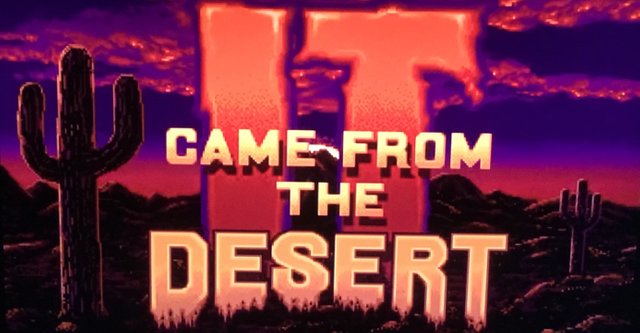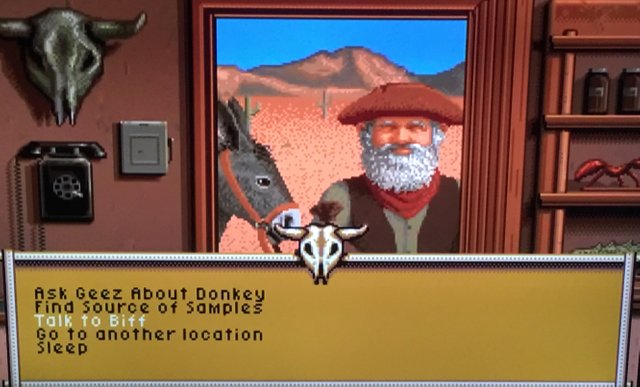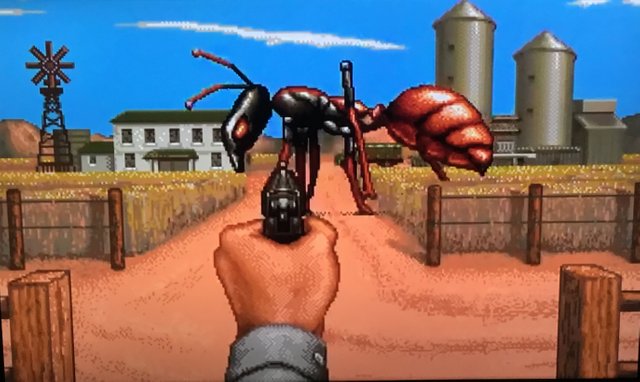Extropia’s Retro Gaming: It Came From The Desert
EXTROPIA’S RETRO-GAMING
‘It Came From The Desert’.
‘The desert. Unchanged for millions of years. Yet witness to a Biblical prophecy come true that, one day, the meek shall inherit the Earth’.

So begins ‘It Came From The Desert’, which was developed by Cinemaware and published by Mirrorsoft and released in 1989. As the company’s name suggests, ‘Cinemaware’ focused on making games with a cinematic flavour. As you can probably tell from its title, ‘It Came From The Desert’ was a homage to 50s B-movies.
The game is set, appropriately enough, in the 1950s. You play the part of Dr. Craig Bradley, a geologist who has come to a small Californian town called Lizard Breath, in order to study meteorite fragments following an impact in the surrounding hills. You soon discover that the meteor was highly radioactive and that its rays have mutated ants, turning them into towering behemoths that threaten the safety of the town. Your main objective is to gather enough evidence to persuade the Mayor to call in the National Guard. If you can find the ants’ nest and kill the queen within 15 days, you win the game.
Although I said this company made cinematic games, in actual fact the limitations of late 80s hardware mean there are no cinematic cutscenes (with the exception of the introductory sequence depicting the meteor strike), no multiple camera angles and no voice-acting. To contemporary eyes, ‘It Came From The Desert’ looks more like an interactive, illustrated storybook. The bulk of the gameplay involves navigating your way around the town by point-and-clicking at points of interest on a map, then choosing among multiple paths of dialogue from characters you may meet along the way.
As you play the game the clock is constantly ticking, with one second in realtime counting as one minute in the game. Time is the real enemy, not only because you have just 15 days before the ants destroy the town, but also because you must manage your time and act accordingly. Travelling anywhere takes time, and different locations are closed at different times of day and night. Your character also needs to get some sleep and will collapse from exhaustion if you keep him awake too long.
The action part of this action-adventure takes the form of a few mini-games. The main one is a very simple shooter in which you must defend yourself against a giant ant. You have a few seconds in which to shoot off its antenna, which is quite tricky to accomplish because you have no crosshair to help with aiming and must instead rely on the impact of the last shot to judge where to aim the next. Should you succeed, the game then switches to a top-down view and you must defend yourself against several ants, killing them with explosives until they retreat.

Along with this simple shooter, there are occasions when your character will be drawn into a knife fight. This consists of a very simple beat-em-up. You can also run into the local gang and be challenged to a game of chicken, which requires you to drive headlong at the gang, and either one of you swerves first or you have a head-on collision. Should you lose at any of these mini-games, the result is not that you lose a life. In fact, you cannot die in this game. Instead, you end up in hospital, with the length of stay determined by the extent of your injuries. You can try to escape, which involves a vaguely Pac-Man-like game with a top-down view of your wheelchair-bound character, negotiating a maze of corridors while evading the doctors and nursed who are chasing you. Should they catch you, you then have no choice but to remain in hospital until your injuries heal.
Once you manage to convince the authorities of the danger, a real-time strategy game becomes available, in which you take charge of the army, the police, construction workers and townsfolk, and decide where to deploy them in order to best defend Lizard Breath.
So, how does the game stand up today? Well, it would probably look a bit simplistic. To modern eyes, the graphics would look rather primitive, with little animation to liven up what is supposed to be a cinematic game. And I cannot stress enough that the gameplay of the mini-games is bareboned to say the least. However, if the largely text-based story can draw you in, there is substantial replayabilty on offer. As I mentioned earlier, the game’s clock is always ticking, and you have to be in the right place at the right time in order to participate in certain events. This means your game can change on replays, as you meet characters to encounter situations you missed on the previous session.
The story does not quite follow the beats of a classic B-Movie. Such a film would typically reveal the truth of what, exactly, came from the desert more slowly than is the case here. The first quarter of the film would throw the audience hints that something is amiss. You might see devastated fields or wrecked vehicles, or the odd strange track or two. Then you would catch glimpses of whatever was responsible, and probably wouldn’t get a good look at the monster until well into the film. But, in ‘It Came From The Desert’, you have your first encounter with a giant ant within minutes of starting the game. I suppose the designers feared video gamers would not appreciate being made to wait long before the main enemy put in an appearance. Still, I can’t help but wonder how the game would have played if there had been more mystery, with the player hunting down clues and building up a picture of what is going on, before finally encountering the ants.

Another mild criticism I have is to do with the skepticism of the Mayor. It is he who you have to convince to call in help, but he always seems to dismiss any evidence you bring him. When you consider that giant ants are attacking the town’s farms and mines, and that several of their corpses have been left rotting in the open air following your encounters, you would think enough credible witnesses would have come along to shake his convictions.
But these are very mild criticisms and provided you are able to make allowances for the limitations of late 80s hardware, this is a decent game. It does no try to drag out the gameplay. In fact, there is nothing to prevent you from going straight to the nest and attempting to find and kill the queen at the earliest opportunity, provided you know where to look for it. I reckon it is one of the best games Cinemaware put out. If you ever wanted to be the protagonist in the movie ‘Them!’, this is the game for you.
Thanks to Mirrorsoft for the images.
it looks like this is an interesting game to play ... kill the ant queen to become a champion.
Congratulations! Your post has been selected as a daily Steemit truffle! It is listed on rank 20 of all contributions awarded today. You can find the TOP DAILY TRUFFLE PICKS HERE.
I upvoted your contribution because to my mind your post is at least 5 SBD worth and should receive 78 votes. It's now up to the lovely Steemit community to make this come true.
I am
TrufflePig, an Artificial Intelligence Bot that helps minnows and content curators using Machine Learning. If you are curious how I select content, you can find an explanation here!Have a nice day and sincerely yours,

TrufflePigI like how you compare the game to a film, and when I saw the last photo, my first thought was "DOOM Clone?" it seems different enough to warrant me wrong.
Why don’t they have Water Bears in this one?
https://en.m.wikipedia.org/wiki/Tardigrade
Thank you for your contribution!
Good fortune.
This post was shared in the Curation Collective Discord community for curators, and upvoted and resteemed by the @c-squared community account after manual review.